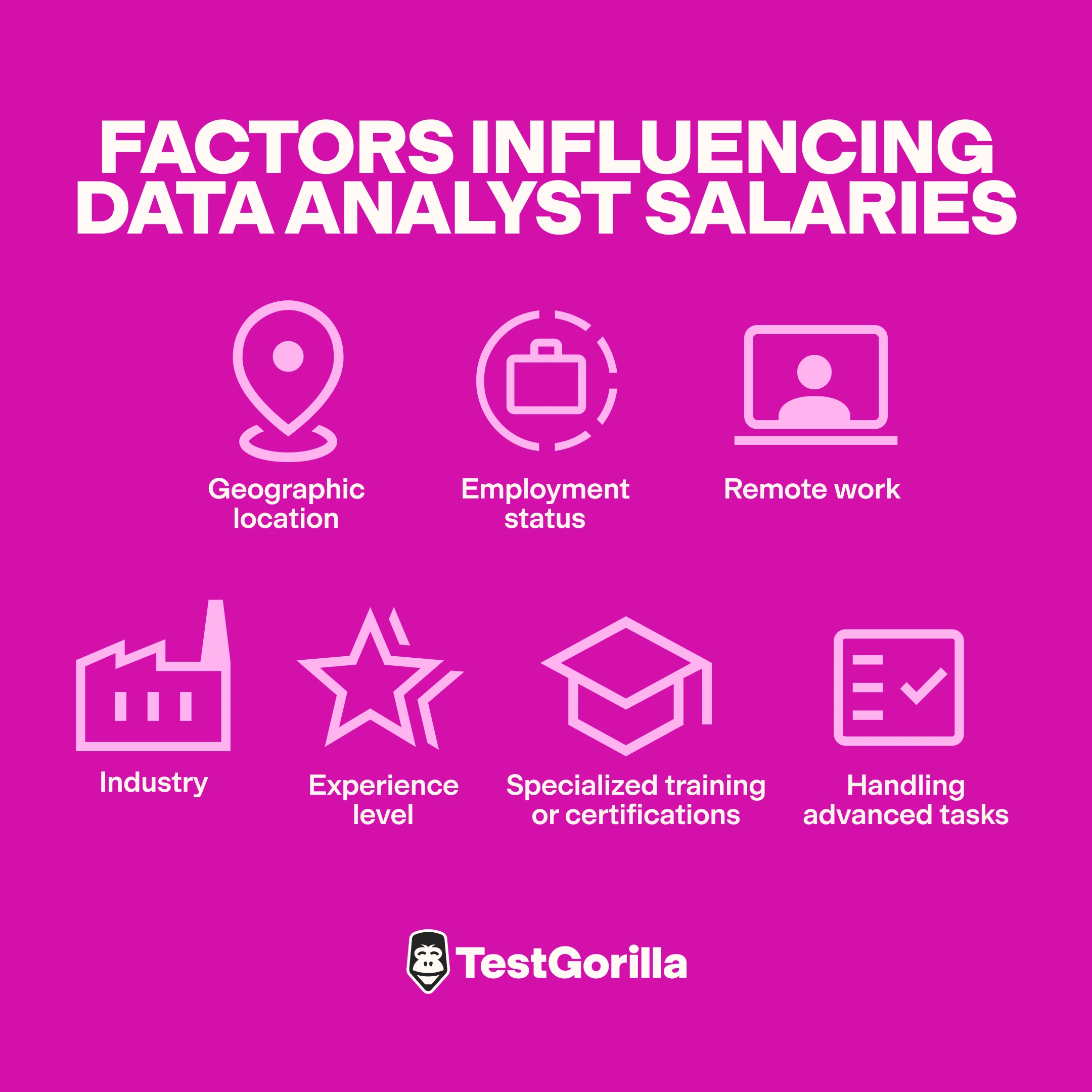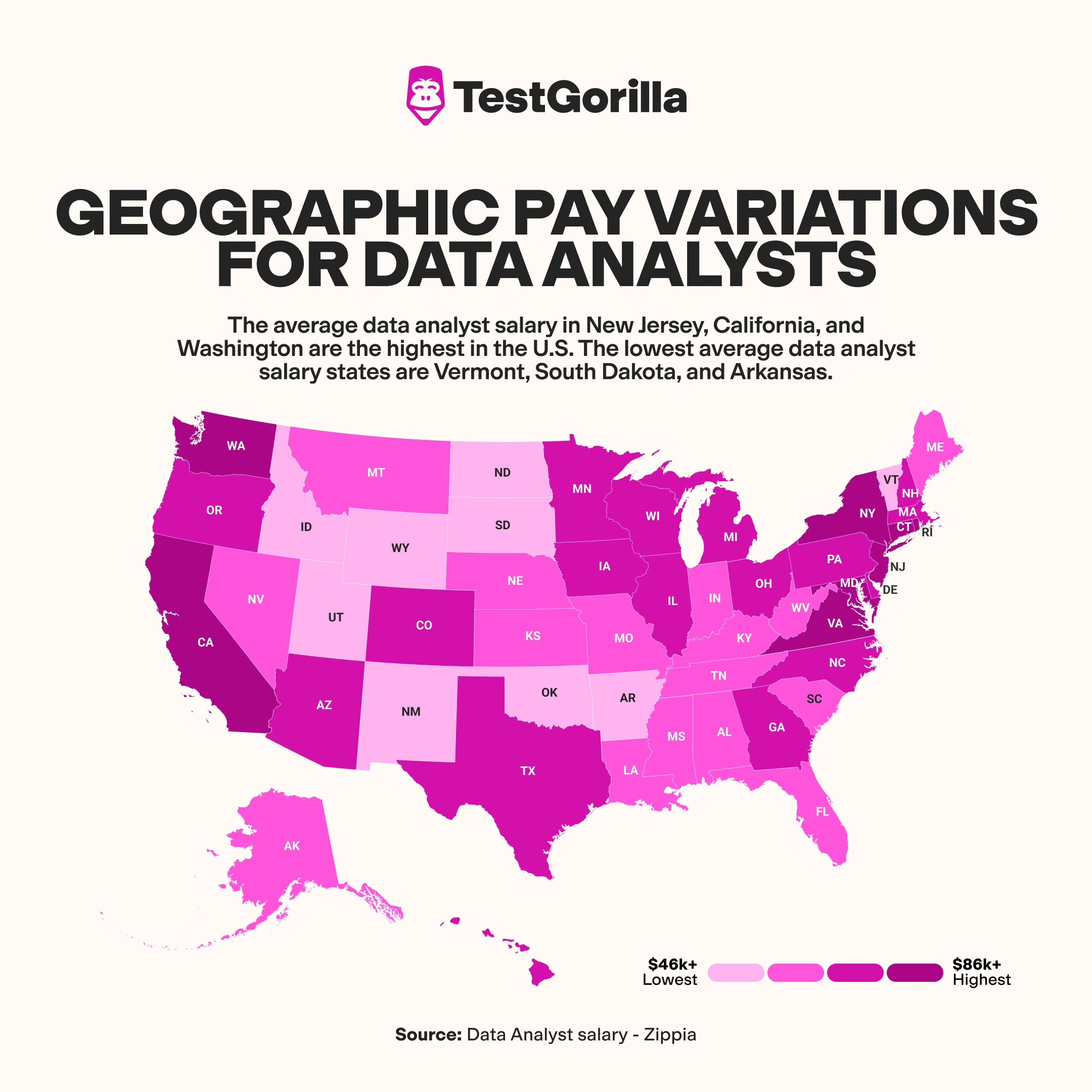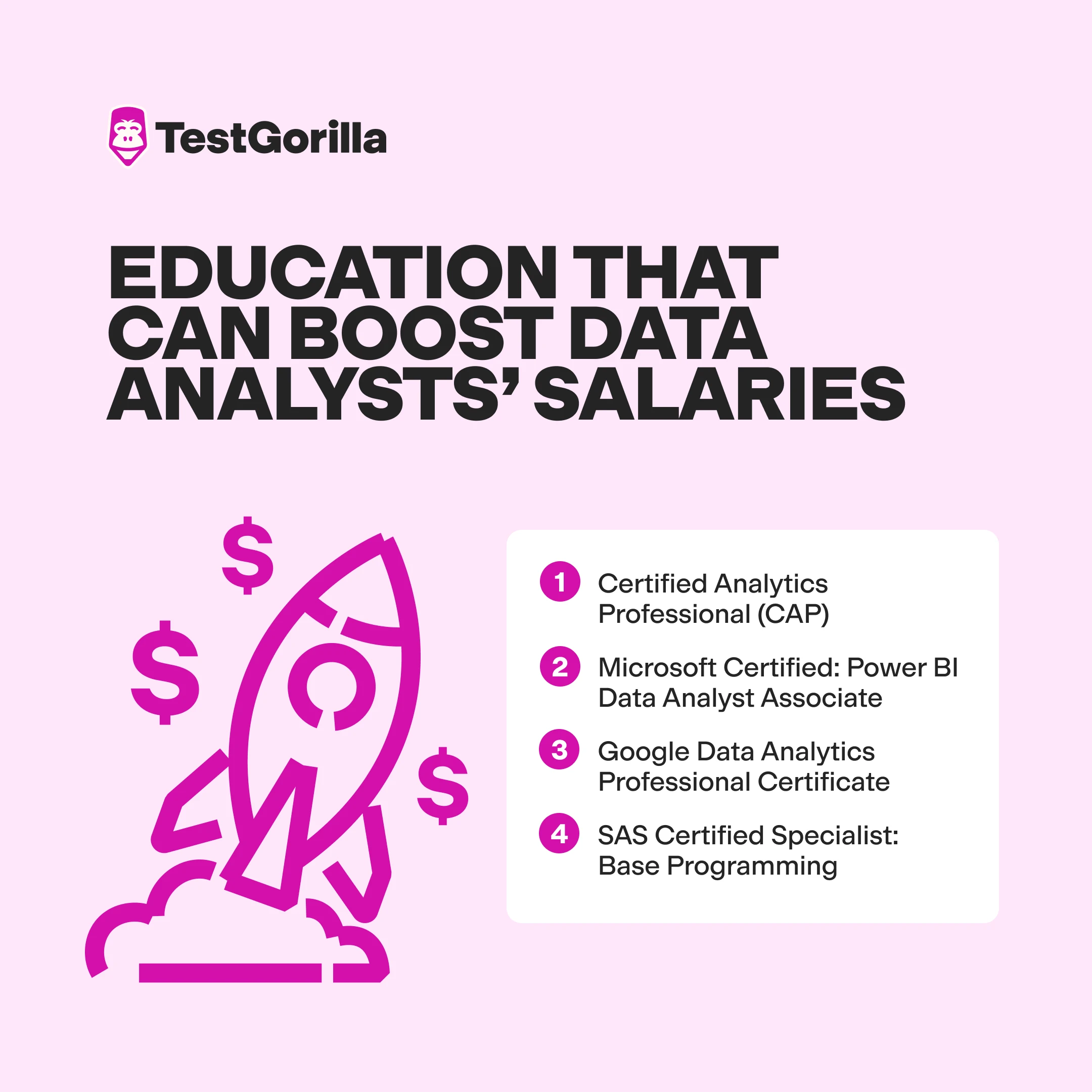If you want to know what to pay a data analyst, you might find it difficult to reach a figure.
Tapping into top talent without big budgets, haziness around salary benchmarks, and justifying wages to leadership are just some of the challenges you might face when trying to settle on the right compensation.
But don’t worry. Below, we dive into the top stats on data analyst salaries in the US and break down what factors matter in compensation so that you can hire the very best.
How we researched this topic
We’ve pulled data from reliable sources, including Salary.com, Indeed, Glassdoor, Zippia, Talent.com, and Apartments.com, to bring you the clearest picture of salaries, costs of living, and geographic trends across the country.
For some roles, official US Bureau of Labor Statistics (BLS) government data is perfect to help gauge compensation packages. However, the BLS doesn’t list a specific category for data analysts – only one for data scientists under Mathematical Science Occupations, which is a different role. As such, we have not drawn on BLS stats for this guide.
Key takeaways
Data analysts in the US earn around $113,500 on average, with top earners bringing in up to $137,525.
Location, industry, and specific skills play a big role in data analysts’ earning power. High-paying fields include finance and IT, while nonprofits, NGOs, legal, entertainment, and hospitality tend to pay data analysts the least.
Benefits like health insurance, retirement plans, professional development, and flexible working arrangements can help attract the best data analysts to open roles.
Incorporating talent assessments into your hiring process can help you identify data analysts who have the right combination of skills and personal qualities to fit your teams.
National salary statistics for data analysts
Pay metric | Annual salary (USD) | Hourly wage (USD) |
Median | 108,946 | 52 |
Mean | 113,500 | 54.18 |
Top 10% earners | 137,525 | 66 |
Bottom 10% earners | 82,691 | 40 |
Median salary vs. mean salary
Salary data can come in two forms: the median and the average (or mean). There is a critical distinction between the two:
The median is the middle value in the total range of salaries for a role. It’s a more accurate figure in assessing what most data analysts actually earn on the job.
The average (mean) is calculated by adding up all salaries for a specific role and dividing it by the total number of people working in that role. Unlike the median, the mean can be skewed by some outlying high earners. However, the mean is useful for assessing earning potential in some industries.
To get the most balanced view of what data analysts earn, consider both the median and average in tandem.
What influences the salary amount?
What data analysts make can depend on one or more of the following:
Geographic location can widely affect pay due to the cost of living and local demand. For instance, data analysts in Washington, DC, and California earn around $80,000 a year, while those in Arkansas and South Dakota earn $53,000 for the same role.
Employment status can also impact pay:
Freelancers set their own rates and cover their own benefits, typically resulting in higher hourly or project-based pay – but they don’t receive perks like health insurance or paid time off (PTO).
In-house employees might earn a lower base salary but gain access to benefits like healthcare, retirement plans, and PTO.
Remote work is a common setup for data analysts, meaning many companies that hire remote analysts can easily save on office space and equipment. Remote-first employers can strategically channel these savings into offering more competitive salaries or robust benefits packages to attract the best talent in the industry.
Industry impacts pay. Data analysts working in finance and IT receive significantly higher salaries than those working in hospitality or nonprofits and NGOs. The former relies heavily on advanced data capabilities, while the latter suffers from budget constraints and differing demand levels.
Experience level plays a significant role in salary progression, with entry-level analysts looking at average salaries of $60,000 and seasoned analysts bringing in $110,000. This is thanks to typically sharper problem-solving skills and technical mastery.
Specialized training or certifications – like Certified Analytics Professional (CAP) or Tableau Specialist – can significantly increase data analysts’ earning potential. Formal education does demonstrate baseline knowledge, but you should always validate candidates’ actual skills through data-driven assessments.
Data analysts who handle advanced tasks like creating predictive models, conducting deep statistical analyses, and managing big data platforms typically earn more than those who have less demanding responsibilities in their roles. Specialized skills and responsibilities add significant value to organizations, justifying higher pay.
Geographic pay variations
The highest-paying areas for data analysts – marked on the map in the darkest color – have an average annual wage of around $79,000 to $80,000 or more. This includes:
State | Average salary | Average hourly rate |
District of Columbia (DC) | $82,711 | $39.76 |
New Jersey | $82,466 | $39.65 |
California | $80,056 | $38.49 |
Washington | $80,018 | $38.47 |
Connecticut | $79,907 | $38.42 |
Meanwhile, the lowest-paying states for data analysts are marked in the lightest color on the map. These states have an average annual wage of around $53,000 or less, and include:
State | Average salary | Average hourly rate |
North Dakota | $47,031 | $22.61 |
Idaho | $51,325 | $24.68 |
Utah | $53,407 | $25.68 |
Arkansas | $53,595 | $25.77 |
South Dakota | $53,843 | $25.89 |
The cost of living in different areas can impact pay. DC renters can expect to pay $2,276 per month on average for an apartment, while those in North Dakota will pay anywhere from a mere third to less than half of this: apartment prices are, on average, just $781 a month for a studio, $917 for a one-bed, and around $1,092 for a two-bed.
Industry-specific data
Below, we’ve compiled a table of the median annual salaries for data analysts grouped by industry. The five top-paying and five bottom-paying industries have been italicized:
Industry | Median annual wage (USD) |
Financial Services | 144,000 |
Aerospace & Defense | 128,000 |
Information Technology | 126,000 |
Management & Consulting | 114,000 |
Transportation & Logistics | 109,000 |
Personal Consumer Services | 106,000 |
Insurance | 106,000 |
Pharmaceutical & Biotechnology | 105,000 |
Retail & Wholesale | 105,000 |
Manufacturing | 104,000 |
Healthcare | 103,000 |
Construction, Repair & Maintenance Services | 102,000 |
Restaurants & Food Service | 100,000 |
Energy, Mining & Utilities | 99,000 |
Human Resources & Staffing | 98,000 |
Government & Public Administration | 97,000 |
Media & Communication | 97,000 |
Telecommunications | 97,000 |
Real Estate | 96,000 |
Agriculture | 92,000 |
Education | 92,000 |
Hotels & Travel Accommodation | 92,000 |
Arts, Entertainment & Recreation | 90,000 |
Legal | 85,000 |
Nonprofit & NGO | 80,000 |
To find industry-specific data for this niche role, we primarily relied on Glassdoor, which takes data like salary estimates and trends from employer job postings and third-party sources.
3 key findings from the data:
Financial services – as the top-paying industry – has a salary range of $113,000 to $187,000 per year for data analysts. This can be broken down as $88,000 to $140,000 annual base pay, with $25,000 to $47,000 in additional income, which can be in the form of bonuses, shares, and stock options.
Lower-paying industries like the legal sector have an equally broad salary range: $67,000 to $107,000. Base pay is $57,000 to $87,000, while additional income is $11,000 to $20,000.
Salaries on the lower end in top-paying jobs aren’t far off the higher end of the lowest-paying industries. For example, highly paid nonprofit and NGO workers can make up to $99,000 annually, while those on the lower end of the aerospace and defense industry’s salary range make around $101,000.
Top 4 reasons for salary differences
Here are some of the reasons that data analyst salaries differ across industries:
Specialized skills: Data analysts with expertise in specific software, tools, or methodologies – like SQL, Python, Tableau, or certain domain knowledge – generally command higher pay. They’re readier to tackle complex challenges and deliver deeper insights than their less specialized counterparts.
Level of responsibility: If businesses task analysts with managing large datasets, delivering executive-level reporting, or leading data-driven initiatives, those analysts will receive higher compensation. The more strategic and impactful their work, the more they’ll be paid.
Industry standards: Different industries maintain unique benchmarks for salaries. High-paying sectors – like finance, aerospace and defense, and IT – often offer more competitive compensation because of how critical data is in driving business decision-making. The consequences of wrong decisions in these industries can be disastrous.
Market competition for talent: Demand for skilled data analysts is skyrocketing. Industries with intense competition – especially those requiring analysts with niche expertise or proficiency in cutting-edge tools – can expect to offer high salaries as companies compete for the best.
All four factors combine to create competition, where the most capable data analysts with the right mix of skills and experience secure premium pay for their work.
Pay by experience and education
Data analysts' salaries vary quite a bit due to differences in their experience and qualifications.
Here’s a breakdown of what data analysts can expect to earn depending on where they are in their career, taken as an average across all of the above industries:
Entry-level (0-1 years): $90,000
Mid-career (4-6 years): $110,000
Experienced (10-14 years): $119,000
Veteran (15+ years): $139,000
Certifications or education that can boost data analyst pay
Earning certifications or completing specialized training can significantly increase a data analyst's earning potential. These include the following:
Certified Analytics Professional (CAP) is an industry-recognized certification offered by INFORMS. It helps data analysts demonstrate expertise in advanced analytics and their ability to deliver actionable business insights – giving them a strategic edge.
Microsoft Certified: Power BI Data Analyst Associate is aimed at analysts proficient in Power BI. It validates skills in data visualization, transforming data sets, and creating actionable reports. The more data-driven the role, the more likely you’ll want analysts proficient or certified in this.
Google Data Analytics Professional Certificate is offered through Coursera, providing foundational and advanced training in tools like SQL, R, and Tableau. It’s a highly regarded qualification for those starting or advancing in data analysis.
SAS Certified Specialist: Base Programming is designed for analysts in industries like finance or healthcare and helps them showcase their proficiency in using SAS for data management and analytics.
Additional specialized certifications can help data analysts stand out and request higher salaries. Here are some of them:
Tableau Desktop Specialist is for data visualization-focused analysts and validates skills in creating impactful dashboards and effectively presenting insights to business management.
AWS Certified Data Analytics – Specialty is designed for analysts working with cloud-based tools and helps them demonstrate expertise in handling big data and building scalable solutions on AWS.
Project Management Professional (PMP) isn’t specific to data analysis but is valuable for data analysts managing large-scale projects or cross-functional teams.
All these certifications enhance technical skills and build credibility, meaning data analysts armed with them can expect higher salaries and do better in more competitive markets than those without the qualifications.
The best insights on HR and recruitment, delivered to your inbox.
Biweekly updates. No spam. Unsubscribe any time.
Benefits beyond salary for data analysts
Salary is just one part of a comprehensive benefits package. Think outside the box to widen the pool to draw in top data analysts.
If you’re struggling to offer a competitive salary but still want a taste of the top talent in the industry, consider providing some of the following:
Comprehensive health insurance covers medical, dental, and vision care and often extends to family members. It’s a major draw for in-house analysts.
Health savings accounts (HSAs) and flexible spending accounts (FSAs) give analysts extra flexibility to manage their healthcare costs more effectively.
PTO is a must – especially for remote workers. Even (and perhaps especially) the most productive best data analysts need set days for vacation, sick leave, and mental health breaks.
Retirement savings plans, like 401(k)s and employer-matched contribution plans, are great for encouraging loyalty and providing talent with long-term security.
Professional development opportunities, including courses, certifications like Tableau or CAP, and company-covered conference fees, show your best analysts that you care about helping them advance in their careers.
Work flexibility is no longer a nice-to-have but a must-have. Give options to set personalized schedules that help analysts align work with their own unique productivity patterns and lifestyles.
Wellness perks like gym memberships and mental health resources are great cherries on top, especially for more high-demand roles.
Equipment stipends and reimbursements are an excellent offering for remote data analysts to help finance home office setups, including the latest hardware and software essentials.
Performance bonuses like extra paid holidays and milestone bonuses can boost morale and enhance engagement for both in-house and freelance analysts.
Level up your hiring process with talent assessments
Data analysts’ wages are generally much higher than many other roles, but there’s still a wide range of figures depending on location, industry, and specific skills. High-paying fields like finance and IT tend to pay data analysts more than less specialized sectors like entertainment and hospitality.
At the same time, benefits – including health insurance, retirement plans, professional development, and flexible working arrangements – can help attract the best data analysts to open roles.
But how do you know what to pay top-of-the-range data analysts? Determining accurate compensation means assessing candidates’ skills.
Thankfully, TestGorilla’s science-backed collection of “400+” tests helps you evaluate the best data analysts on the market. You’ll be able to assess their organization, multitasking, and communication skills and capabilities – a better approach than just scanning resumes.
Here are some tests you can use to help assess and ultimately attract the top data analysts in the industry:
Communication test
Personality and culture tests
Combine up to five tests to create a custom assessment. TestGorilla automatically scores candidates for you, so you can easily spot top-level data analysts and interview them with targeted questions to test their true skills and abilities.
Sign up for a free account to see how TestGorilla can simplify hiring your next data analyst. Post your job openings and salaries on our remote job board to tap into top data analyst talent today!
FAQs
Which country pays a data analyst the most?
Data analysts are offered the highest-paying salaries in countries such as Switzerland (CHF 86,354 on average), the US (USD 67,349 on average), Denmark (DKK 408,309 on average), and Germany (EUR 48,825 on average).
Is data analysis in demand?
Data analyst roles are in high demand across many industries since companies increasingly rely on data-driven insights to guide their strategies.
Will AI data analysis replace human data analysts?
The short answer is no. While AI is taking on more routine tasks previously done by humans, this frees up human data analysts to focus on higher-level strategic work, like identifying trends – something AI currently can’t do as well as humans – and supporting decision-making for management and leadership.
You've scrolled this far
Why not try TestGorilla for free, and see what happens when you put skills first.

















